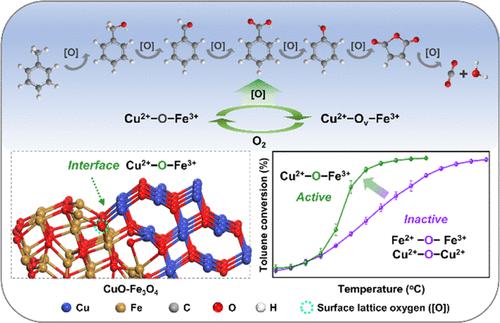当前位置:
X-MOL 学术
›
Environ. Sci. Technol.
›
论文详情
Our official English website, www.x-mol.net, welcomes your
feedback! (Note: you will need to create a separate account there.)
Constructing Active Cu2+–O–Fe3+ Sites at the CuO–Fe3O4 Interface to Promote Activation of Surface Lattice Oxygen
Environmental Science & Technology ( IF 10.8 ) Pub Date : 2023-10-31 , DOI: 10.1021/acs.est.3c05431
Dandan Zhu 1, 2 , Yu Huang 1, 2 , Rong Li 1, 2 , Shiqi Peng 1, 2 , Pengge Wang 1, 2 , Jun-Ji Cao 3
Environmental Science & Technology ( IF 10.8 ) Pub Date : 2023-10-31 , DOI: 10.1021/acs.est.3c05431
Dandan Zhu 1, 2 , Yu Huang 1, 2 , Rong Li 1, 2 , Shiqi Peng 1, 2 , Pengge Wang 1, 2 , Jun-Ji Cao 3
Affiliation

|
Activating surface lattice oxygen (Olatt) through the modulation of metal–oxygen bond strength has proven to be an effective route for facilitating the catalytic degradation of volatile organic compounds (VOCs). Although this strategy has been implemented via the construction of the TM1–O–TM2 (TM represents a transition metal) structure in various reactions, the underlying principle requires exploration when using different TMs. Herein, the Cu2+–O–Fe3+ structure was created by developing CuO–Fe3O4 composites with enhanced interfacial effect, which exhibited superior catalytic activity to their counterparts, with T90 (the temperature of toluene conversion reaching 90%) decreasing by approximately 50 °C. Structural analyses and theoretical calculations demonstrated that the active Cu2+–O–Fe3+ sites at the CuO–Fe3O4 interface improved low-temperature reducibility and oxygen species activity. Particularly, X-ray absorption fine structure spectroscopy revealed the contraction and expansion of Cu–O and Fe–O bonds, respectively, which were responsible for the activation of the surface Olatt. A mechanistic study revealed that toluene can be oxidized by rapid dehydrogenation of methyl assisted by the highly active surface Olatt and subsequently undergo ring-opening and deep mineralization into CO2 following the Mars-van Krevelen mechanism. This study provided a novel strategy to explore interface-enhanced TM catalysts for efficient surface Olatt activation and VOCs abatement.
中文翻译:

在 CuO-Fe3O4 界面构建活性 Cu2+-O-Fe3+ 位点促进表面晶格氧的活化
通过调节金属-氧键强度来激活表面晶格氧(Olatt )已被证明是促进挥发性有机化合物(VOC)催化降解的有效途径。尽管该策略已通过在各种反应中构建TM 1 –O–TM 2(TM代表过渡金属)结构来实现,但在使用不同TM时,其基本原理还需要探索。在此,通过开发具有增强界面效应的CuO-Fe 3 O 4复合材料来创建Cu 2+ -O-Fe 3+结构,其表现出优于同类材料的催化活性,T 90(甲苯转化率达到90%的温度) ) 降低约 50 °C。结构分析和理论计算表明, CuO-Fe 3 O 4界面处的活性Cu 2+ -O-Fe 3+位点提高了低温还原性和氧物种活性。特别是,X射线吸收精细结构光谱分别揭示了Cu-O和Fe-O键的收缩和膨胀,这导致了表面Olatt的活化。机理研究表明,在高活性表面Olatt的辅助下,甲基快速脱氢可将甲苯氧化,随后按照Mars-van Krevelen机制进行开环和深度矿化成CO 2 。这项研究提供了一种新的策略来探索界面增强型TM催化剂,以实现有效的表面Olatt活化和VOCs减排。
更新日期:2023-10-31
中文翻译:

在 CuO-Fe3O4 界面构建活性 Cu2+-O-Fe3+ 位点促进表面晶格氧的活化
通过调节金属-氧键强度来激活表面晶格氧(Olatt )已被证明是促进挥发性有机化合物(VOC)催化降解的有效途径。尽管该策略已通过在各种反应中构建TM 1 –O–TM 2(TM代表过渡金属)结构来实现,但在使用不同TM时,其基本原理还需要探索。在此,通过开发具有增强界面效应的CuO-Fe 3 O 4复合材料来创建Cu 2+ -O-Fe 3+结构,其表现出优于同类材料的催化活性,T 90(甲苯转化率达到90%的温度) ) 降低约 50 °C。结构分析和理论计算表明, CuO-Fe 3 O 4界面处的活性Cu 2+ -O-Fe 3+位点提高了低温还原性和氧物种活性。特别是,X射线吸收精细结构光谱分别揭示了Cu-O和Fe-O键的收缩和膨胀,这导致了表面Olatt的活化。机理研究表明,在高活性表面Olatt的辅助下,甲基快速脱氢可将甲苯氧化,随后按照Mars-van Krevelen机制进行开环和深度矿化成CO 2 。这项研究提供了一种新的策略来探索界面增强型TM催化剂,以实现有效的表面Olatt活化和VOCs减排。

































 京公网安备 11010802027423号
京公网安备 11010802027423号